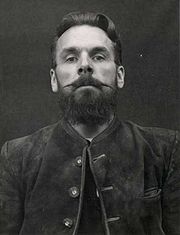
Wolfram Sievers
Encyclopedia

Ahnenerbe
The Ahnenerbe was a Nazi German think tank that promoted itself as a "study society for Intellectual Ancient History." Founded on July 1, 1935, by Heinrich Himmler, Herman Wirth, and Richard Walther Darré, the Ahnenerbe's goal was to research the anthropological and cultural history of the Aryan...
from 1935 to 1945.
Early life
Sievers was born in 1905 in Hildesheim, the son of a Protestant church musician. It is reported that he was musically gifted, that he played the harpsichord, organ, and piano, and loved German baroque musicBaroque music
Baroque music describes a style of Western Classical music approximately extending from 1600 to 1760. This era follows the Renaissance and was followed in turn by the Classical era...
. He was expelled from school for being active in the Deutschvölkischer Schutz und Trutzbund
Deutschvölkischer Schutz und Trutzbund
The Deutschvölkischer Schutz und Trutzbund was the largest, most active, and most influential anti-Semitic federation in Germany after the first World War, and one of the largest and most important organization of the German völkisch movement during the Weimar Republic, whose...
and went on to study history, philosophy, and religious studies at Stuttgart's Technical University while working as a salesman. A member of the Bündische Jugend, he became active in the Artamanen-Gesellschaft ("Artaman League
Artaman League
The Artaman League was a German agrarian and völkisch movement dedicated to a Blut und Boden-inspired ruralism. Active during the inter-war period, the League became closely linked to, and eventually absorbed by, the Nazi Party.-Etymology:The term Artamanen had been coined before the First World...
"), a nationalist back-to-the-land movement.
Ahnenerbe
Sievers joined the NSDAP in 1929. In 1933 he headed up the Externsteine-Stiftung ("Externsteine Foundation"), which had been founded by Heinrich Himmler to study the ExternsteineExternsteine
The Externsteine are a distinctive rock formation located in Ostwestfalen-Lippe of northwestern Germany, not far from the city of Detmold at Horn-Bad Meinberg. The formation is a tor consisting of several tall, narrow columns of rock which rise abruptly from the surrounding wooded hills...
in the Teutoburger Wald. In 1935, having joined the SS that year, Sievers was appointed Reichsgeschäftsführer, or General Secretary, of the Ahnenerbe, by Himmler. He was the actual director of Ahnenerbe operations and was to rise to the rank of SS-Standartenführer by the end of the war.
In 1943 Sievers became director of the Institut für Wehrwissenschaftliche Zweckforschung (Institute for Military Scientific Research), which conducted extensive experiments using human subjects. He also assisted in assembling a collection of skulls and skeletons for August Hirt
August Hirt
August Hirt , an SS-Hauptsturmführer , served as a chairman at the Reich University in Strasbourg during World War II....
's study at the Reichsuniversität Straßburg
Reichsuniversität Straßburg
The Reichsuniversität Straßburg was founded 1941 by the National Socialists in Alsace while the regular University of Strasbourg had moved to Clermont-Ferrand since 1940. The purpose was to create a continuity to the German character of the German Imperial University of Strasbourg, that had been...
as a part of which 112 Jewish prisoners were selected and killed
Jewish skeleton collection
The Jewish skeleton collection was an attempt by the Nazis to create an anthropological display to showcase the alleged racial inferiority of the "Jewish race" and to emphasize the Jews status as untermenschen as opposed to the German race which the Nazis considered to be Aryan ubermenschen...
, after being photographed and their anthropological measurements taken.
Trial and execution
Sievers was tried during the Doctors' TrialDoctors' Trial
The Doctors' Trial was the first of 12 trials for war crimes that the United States authorities held in their occupation zone in Nuremberg, Germany after the end of World War II. These trials were held before U.S...
at Nuremberg following the end of World War II, where he was dubbed "the Nazi Bluebeard" by journalist William L. Shirer
William L. Shirer
William Lawrence Shirer was an American journalist, war correspondent, and historian, who wrote The Rise and Fall of the Third Reich, a history of Nazi Germany read and cited in scholarly works for more than 50 years...
because of his "thick, ink-black beard". As the Institute for Military Scientific Research had been set up as part of the Ahnenerbe, the prosecution at Nuremberg laid the responsibility for the experiments on humans which had been conducted under its auspices on the Ahnenerbe, and Sievers, as its highest administrative officer, was accused of actively aiding and promoting the criminal experiments.
Sievers was charged with being a member of an organization declared criminal by the International Military Tribunal (the SS), and was implicated in the commission of war crimes and crimes against humanity. In his defense, he alleged that as early as 1933, he had been a member of an anti-Nazi resistance movement which planned to assassinate Hitler and Himmler, and that he had obtained his appointment as Manager of the Ahnenerbe so as to get close to Himmler and observe his movements. He further claimed that he remained in the post on the advice of his resistance leader to gather vital information which would assist in the overthrow of the Nazi regime.
Sievers was sentenced to death on 20 August 1947 for crimes against humanity, and hanged on 2 June 1948, at Landsberg prison
Landsberg Prison
Landsberg Prison is a penal facility located in the town of Landsberg am Lech in the southwest of the German state of Bavaria, about west of Munich and south of Augsburg....
in Bavaria
Bavaria
Bavaria, formally the Free State of Bavaria is a state of Germany, located in the southeast of Germany. With an area of , it is the largest state by area, forming almost 20% of the total land area of Germany...
.
External links
- Befragung beim Nürnberger Prozess (Englische Fassung)
- Kriegsverbrechergefängnis (WCP No 1) Landsberg
- Michael H. Kater: Das "Ahnenerbe" der SS 1935-1945. Oldenbourg Verlag, 2001, ISBN 3-486-56529-X
- Hans-Joachim Lang: Die Namen der Nummern. Hoffmann und Campe, 2004, ISBN 3-455-09464-3

